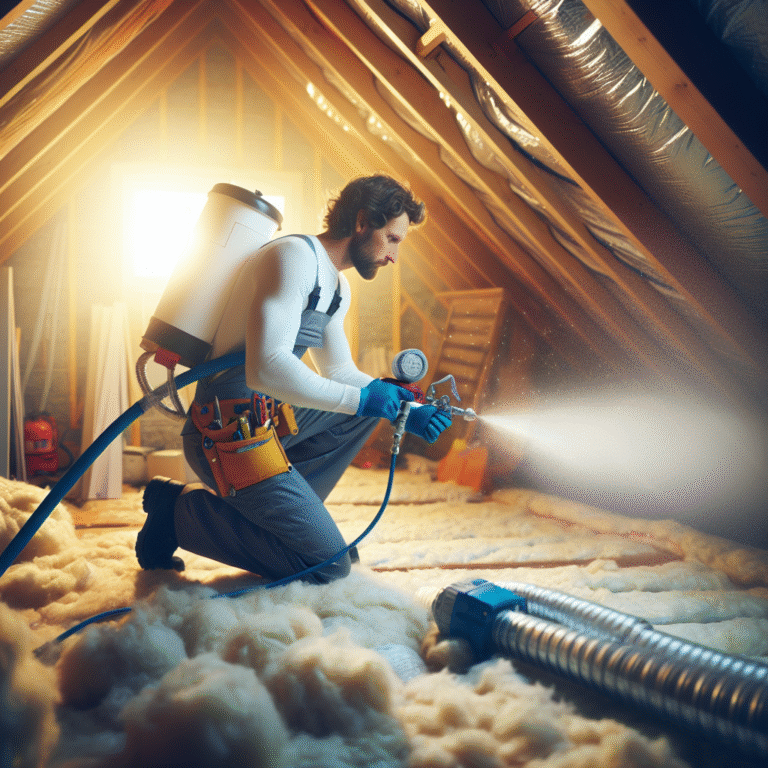-
Table of Contents
“Seal in savings and comfort with spray foam insulation – the ultimate choice for energy efficiency and insulation needs.”
“Are you considering installing spray foam insulation in your home? Before you do, make sure you have all the necessary information. From its benefits to the installation process, educate yourself on spray foam insulation by visiting texasinsulationsolution.com. Don’t miss out on the opportunity to improve your home’s energy efficiency and comfort. Click here to learn more about spray foam insulation today!” texasinsulationsolution.com
Introduction
Spray foam insulation is a popular choice for homeowners looking to improve the energy efficiency of their homes. It is a type of insulation that is applied as a liquid and then expands to fill and seal gaps and cracks in walls, ceilings, and other areas. This creates a barrier that helps to prevent air leakage and can significantly reduce heating and cooling costs. However, before deciding to install spray foam insulation, there are a few important things that homeowners should know. In this article, we will discuss the basics of spray foam insulation and what you need to consider before making the investment.
Benefits of Professional Removal of Old Insulation Before Installing Spray Foam
Spray foam insulation has become a popular choice for homeowners looking to improve the energy efficiency of their homes. It offers numerous benefits, such as reducing energy costs, improving indoor air quality, and increasing the overall comfort of a home. However, before installing spray foam insulation, it is important to consider the benefits of professional removal of old insulation.
One of the main benefits of professional removal of old insulation before installing spray foam is the improved effectiveness of the new insulation. Over time, traditional insulation materials such as fiberglass or cellulose can become compressed, settle, or even become damaged. This can result in gaps and voids in the insulation, reducing its effectiveness in keeping the home properly insulated. By removing the old insulation, these gaps and voids can be identified and filled before the new spray foam insulation is installed, ensuring maximum effectiveness.
Another benefit of professional removal of old insulation is the improved air quality in the home. Over time, traditional insulation materials can become a breeding ground for mold, mildew, and other allergens. These can negatively impact the air quality in a home, leading to respiratory issues and other health concerns. By removing the old insulation, these potential health hazards can be eliminated, creating a healthier living environment for homeowners and their families.
In addition to improving the effectiveness of the new insulation and the air quality in a home, professional removal of old insulation can also help identify any underlying issues that may need to be addressed. During the removal process, professionals can inspect the walls, ceilings, and attic for any signs of water damage, pest infestations, or structural issues. These issues can then be addressed before the new insulation is installed, preventing any potential problems in the future.
Furthermore, professional removal of old insulation can also save homeowners time and money in the long run. While it may seem like a cost-saving measure to simply install spray foam insulation over the existing insulation, this can actually lead to more problems down the road. As mentioned earlier, old insulation can become compressed or damaged, creating gaps and voids that can reduce the effectiveness of the new insulation. This can result in higher energy bills and the need for additional insulation in the future. By removing the old insulation, homeowners can ensure that their new spray foam insulation will be properly installed and provide long-lasting energy savings.
It is also important to note that professional removal of old insulation is a job best left to the experts. Removing old insulation can be a messy and time-consuming process, and it requires specialized equipment and training. Attempting to remove old insulation on your own can not only be dangerous, but it can also lead to incomplete removal and potential health hazards. Professional insulation removal companies have the necessary equipment and expertise to safely and effectively remove old insulation, ensuring a smooth and efficient installation of the new spray foam insulation.
In conclusion, while spray foam insulation offers numerous benefits for homeowners, it is important to consider the benefits of professional removal of old insulation before installation. This process can improve the effectiveness of the new insulation, improve air quality, identify any underlying issues, and save time and money in the long run. It is a crucial step in ensuring that your home is properly insulated and energy-efficient. So, before you make the decision to install spray foam insulation, be sure to consult with a professional insulation removal company to ensure the best results for your home.
The Importance of Safe Insulation Practices When Using Spray Foam
Spray foam insulation has become a popular choice for homeowners looking to improve the energy efficiency of their homes. It is a type of insulation that is applied as a liquid and then expands to fill gaps and crevices, creating a tight seal. While spray foam insulation can be an effective way to reduce energy costs and improve comfort in your home, it is important to understand the potential risks and safety precautions that come with its installation.
One of the main concerns with spray foam insulation is the chemicals used in the process. Spray foam insulation is made up of two components, polyol resin and isocyanate, which are mixed together at the time of installation. These chemicals can be hazardous if not handled properly, making it crucial to follow safe insulation practices when using spray foam.
First and foremost, it is important to wear protective gear when installing spray foam insulation. This includes gloves, goggles, and a respirator mask. The chemicals used in spray foam insulation can irritate the skin, eyes, and respiratory system, so it is essential to protect yourself from direct contact.
In addition to personal protective equipment, proper ventilation is crucial when using spray foam insulation. The chemicals used in the process can release harmful fumes, so it is important to have proper airflow in the area where the insulation is being installed. This can be achieved by opening windows and doors or using fans to circulate fresh air.
Another important safety precaution when using spray foam insulation is to cover and protect any exposed skin. If the chemicals come into contact with your skin, it can cause irritation and even chemical burns. It is recommended to wear long sleeves, pants, and closed-toe shoes to minimize the risk of exposure.
It is also important to note that spray foam insulation should only be installed by trained professionals. While DIY kits are available, it is best to leave the installation to those who have been properly trained and have experience working with the chemicals involved. This will ensure that the insulation is applied correctly and safely.
Furthermore, it is crucial to follow the manufacturer’s instructions when using spray foam insulation. Each product may have specific guidelines and safety precautions that need to be followed. It is important to read and understand these instructions before beginning the installation process.
In addition to the safety precautions during installation, it is also important to consider the long-term effects of spray foam insulation. While it can be an effective way to reduce energy costs, it is important to understand that the chemicals used in the process can release harmful fumes over time. This is why proper ventilation is crucial, even after the installation is complete.
If you are considering using spray foam insulation in your home, it is important to weigh the potential risks and benefits. While it can be a great way to improve energy efficiency, it is essential to follow safe insulation practices to protect yourself and your family from potential harm.
In conclusion, spray foam insulation can be a great option for homeowners looking to improve the energy efficiency of their homes. However, it is important to understand the potential risks and safety precautions that come with its installation. By wearing protective gear, ensuring proper ventilation, and following manufacturer’s instructions, you can safely and effectively use spray foam insulation in your home. Remember, when it comes to your safety, it is always better to be cautious and take the necessary precautions.
Key Considerations for Installing Spray Foam Insulation in Different Areas of Your Home
Spray foam insulation has become a popular choice for homeowners looking to improve the energy efficiency of their homes. This type of insulation is made of polyurethane foam, which is sprayed onto surfaces and expands to fill gaps and cracks, creating a tight seal. While spray foam insulation offers many benefits, such as reducing energy costs and improving indoor air quality, there are some key considerations to keep in mind before installing it in different areas of your home.
One of the first things to consider is the type of spray foam insulation you will be using. There are two main types: open-cell and closed-cell. Open-cell foam is less dense and has a lower R-value, making it better suited for interior walls and ceilings. Closed-cell foam, on the other hand, is denser and has a higher R-value, making it a better choice for exterior walls and areas that require a higher level of insulation. It is important to choose the right type of spray foam insulation for each area of your home to ensure maximum effectiveness.
Another key consideration is the climate in which you live. If you live in a colder climate, you may want to consider using closed-cell foam in all areas of your home to provide better insulation against the cold. In warmer climates, open-cell foam may be sufficient for most areas, but closed-cell foam may be necessary for areas that are prone to high humidity or moisture, such as basements or crawl spaces. It is important to consult with a professional to determine the best type of spray foam insulation for your specific climate and home.
When it comes to installing spray foam insulation, it is crucial to properly prepare the area beforehand. This includes cleaning and sealing any gaps or cracks, as well as removing any existing insulation. If the area is not properly prepared, the spray foam may not adhere properly and could result in air leaks and reduced effectiveness. It is also important to ensure that the area is dry before installation, as moisture can affect the adhesion and effectiveness of the foam.
One area of the home that requires special consideration when it comes to spray foam insulation is the attic. Attics are often the most poorly insulated area of a home, and spray foam insulation can be a great solution. However, it is important to properly ventilate the attic to prevent moisture buildup, which can lead to mold and other issues. It is also important to leave a gap between the insulation and the roof to allow for proper air flow. Consulting with a professional is recommended for attic insulation to ensure proper installation and ventilation.
Another area that may require special consideration is the basement. Basements are often prone to moisture and can benefit greatly from spray foam insulation. However, it is important to address any existing moisture issues before installing the insulation. This may include waterproofing the walls and floors and installing a vapor barrier. It is also important to properly seal any gaps or cracks in the basement walls before installing the spray foam insulation.
In conclusion, spray foam insulation can be a great choice for improving the energy efficiency of your home. However, it is important to consider factors such as the type of foam, climate, and proper preparation before installation. Consulting with a professional can help ensure that the spray foam insulation is installed correctly and effectively in each area of your home. With proper installation and maintenance, spray foam insulation can provide long-term benefits for your home and your wallet.
Q&A
1. What is spray foam insulation?
Spray foam insulation is a type of insulation material that is applied using a spray gun. It is made of a combination of chemicals that react and expand to create a foam that fills gaps and seals air leaks in walls, ceilings, and other areas of a building.
2. What are the benefits of using spray foam insulation?
Spray foam insulation has several benefits, including improved energy efficiency, better air quality, and increased structural strength. It also helps to reduce noise levels and can prevent moisture and mold growth.
3. What should I consider before installing spray foam insulation?
Before installing spray foam insulation, it is important to consider the cost, the type of spray foam being used, and the expertise of the installer. It is also important to ensure that the area being insulated is properly prepared and that any potential hazards, such as electrical wiring, are addressed beforehand. Additionally, it is important to understand the maintenance and potential health risks associated with spray foam insulation.
Conclusion
In conclusion, spray foam insulation is a popular and effective method for insulating homes and buildings. It offers numerous benefits such as improved energy efficiency, noise reduction, and moisture control. However, before installing spray foam insulation, it is important to consider factors such as cost, proper installation techniques, and potential health hazards. It is also crucial to consult with a professional and ensure that the insulation is suitable for your specific needs and environment. By understanding the important aspects of spray foam insulation, you can make an informed decision and enjoy the benefits of a well-insulated space.




